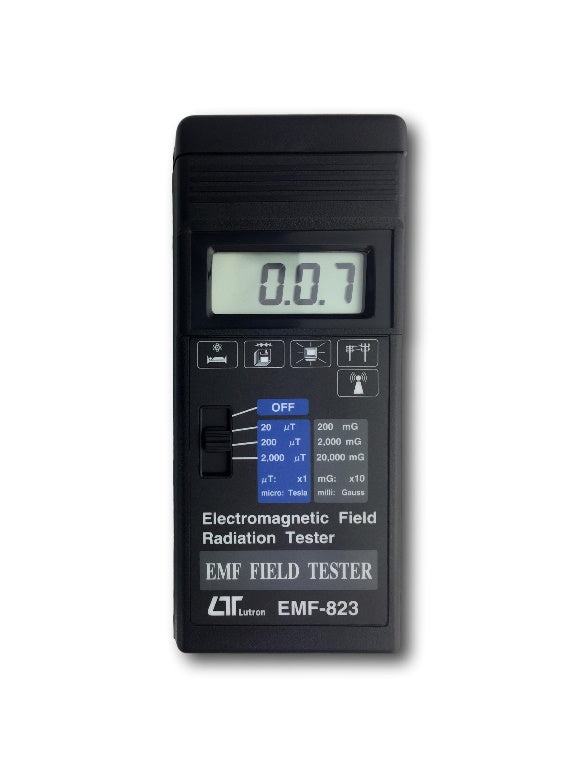Electromagnetic field meters, more commonly known as EMF meters, are popular tools for around the home and in the workplace. This article details how EMF meters measure this radiation, we provide some applications and profile some outstanding product examples.
About Electromagnetic Fields
Electromagnetic fields occur in nature and from human-made sources. Natural examples include electrical charges from thunderstorms or the Earth's magnetic field. X-Rays, TV antennas, electrical wiring, and electrical appliances are well-known industrial sources.
Electromagnetic fields have different frequencies and wavelengths. As you can see in figure 1 (below), the higher the frequency, the shorter the wavelength and, the lower the frequency, the greater the wavelength.
AC and DC currents both generate electromagnetic fields that are the combination of electric and magnetic energy. Stationary charges cause an electric field measured in volts per metre (V/m). A magnetic field created by moving charges (i.e., currents), produces flux densities measured in MicroTesla (µT) or MilliTesla (mT).
 Figure 1: Depicts the electromagnetic spectrum, including the wavelengths visible to the human eye.
Figure 1: Depicts the electromagnetic spectrum, including the wavelengths visible to the human eye.
Types of EMF Meters and What They Measure
EMF meters can measure both AC electromagnetic fields (sometimes referred to as Gauss meters or Magnetometers) or DC fields. The more sophisticated meters measure both.
EMF meters have a variety of uses. They are used to test appliances around the home, check the EMF emitted from powerlines and other troubleshooting applications.
There are two main groups of EMF meters. These are single-axis and tri-axis meters.
- Single-axis meters measure one dimension on the field. You have to tilt and turn these meters to obtain a full-field measurement. Single-axis meters are more affordable than tri-axis meters.
- Tri-axis meters are often more expensive than single-axis meters because they obtain faster results by measuring three axes at once.
Product Examples
The Instrument Choice scientists have assembled an example of a single and tri-axis EMF meter to help grow your understanding of the variety of EMF meters and their differing features.
Single Axis Meter
Handheld EMF Radiation Tester
Product Code: EMF-823
The EMF-823 is a reliable, handheld EMF radiation tester that quickly determines the EMF levels around power lines, industrial devices and home appliances. It is lightweight, easy to use, and provides EMF results in as little as 0.4 seconds.
Quick Specifications
- Measurement Units: MicroTesla, Milli Gauss
- Accuracy:
- ± (4 % + 3 d) - 20 micro Tesla/200 milli Gauss range.
- ± (5 % + 3 d) - 200 micro Tesla/2,000 milli Gauss range.
- ± (10 % + 5 d) - 2,000 micro Tesla/20,000 milli Gauss range. * Spec. accuracy tested under 50 Hz or 60 Hz
- Range Tesla:
- 20 micro Tesla x 0.01 micro Tesla
- 200 micro Tesla x 0.1 micro Tesla
- 2,000 micro Tesla x 1 micro Tesla
- Range Gauss:
- 200 milli Gauss x 0.1 milli Gauss
- 2,000 milli Gauss x 1 milli Gauss
- 20,000 milli Gauss x 10 milli Gauss
- Measurement Axis: Single Axis
- Size and weight: 163mm x 68mm x 24mm, 215 grams.
Tri-Axis Meter
3 Axis Handheld Electromagnetic Field (EMF) Tester
Product Code: EMF-828
The EMF-828 is an accurate, handheld EMF tester with a separate probe for simple remote operation. The device utilises a three-axis EMF measurement to determine the radiation levels around power lines, TV sets, computer monitors, video machinery, and similar devices.
Quick Specifications
- Measurement Units: Micro Tesla and Milli Gauss
- Accuracy:
- ± (4 % + 3 d) at 20 micro Tesla/200 milli Gauss range.
- ± (5 % + 3 d) at 200 micro Tesla/2,000 milli Gauss range.
- ± (10 % + 5 d) at 2,000 micro Tesla/20,000 milli Gauss range
- Range Tesla:
- 20 micro Tesla x 0.01 micro Tesla
- 200 micro Tesla x 0.1 micro Tesla
- 2,000 micro Tesla x 1 micro Tesla
- Range Gauss:
- 200 milli Gauss x 0.1 milli Gauss
- 2,000 milli Gauss x 1 milli Gauss
- 20,000 milli Gauss x 10 milli Gauss
- Measurement Axis: Tri-Axi
- Size and weight: 237 x 60 x 60mm, 200 grams
Conclusion
EMF meters are increasingly popular tools used that efficiently measure the electromagnetic field radiating from an item or within a specific area. Having an understanding of wavelength, frequency and, identifying the source(s) you wish to measure will help you find the perfect EMF meter to suit your application.
Want more information on any of the products above? Have more questions about EMF meters and their use? Contact one of the Instrument Choice Scientists. We’re here to help!
Call 1300 737 871 or email customer-service@instrumentchoice.com.au.
Source: See Electromagnetic fields (EMF)


